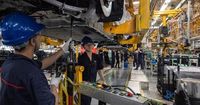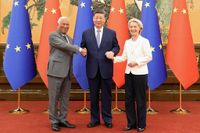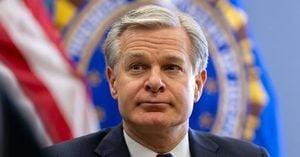On Thursday, July 24, 2025, the European Union and China met in Beijing for a high-stakes summit marked by deep tensions over trade imbalances, the ongoing war in Ukraine, and geopolitical uncertainty. Despite the fraught atmosphere and a summit that was cut short from two days to one at China’s request, the two global powers found a rare moment of consensus: climate change.
European Commission President Ursula von der Leyen and European Council President António Costa led the EU delegation to the Chinese capital, where they met with President Xi Jinping and other senior officials. The summit underscored the complexities of EU-China relations, with little progress on contentious issues like trade and the war in Ukraine, but a joint statement on climate cooperation emerged as a significant silver lining.
The joint climate declaration called for intensified efforts to reduce emissions, greater use of green technologies, and reaffirmed support for the Paris Climate Agreement. Both sides pledged to submit updated national climate plans, known as nationally determined contributions (NDCs), covering all economic sectors and greenhouse gases ahead of COP30, the United Nations climate summit scheduled for November in Brazil. These plans aim to align with the Paris Agreement’s goals of limiting global warming to well below 2 degrees Celsius and striving for 1.5 degrees above pre-industrial levels.
In their joint statement, the EU and China emphasized the importance of “policy continuity and stability” among major economies amid the “fluid and turbulent international situation.” They stressed that stronger cooperation on climate action holds “great and special significance” for upholding multilateralism and advancing global climate governance. The timing was notable, coming just a day after the International Court of Justice issued a landmark ruling reinforcing states’ legal obligations to protect people from climate change impacts.
Climate experts welcomed the statement as a stabilizing signal in an increasingly fragmented geopolitical landscape, especially as the United States continues its withdrawal from international climate diplomacy. The US formally announced in January 2025 that it would leave the Paris Agreement within a year, casting uncertainty over its participation in COP30. David Waskow, international climate director at the World Resources Institute, noted, “Stronger climate leadership from the two major emitters is critically needed to rekindle global momentum.”
Despite the positive climate rhetoric, experts urged both the EU and China to increase their ambition. Belinda Schäpe, a China policy analyst, suggested China could reduce emissions by at least 30% from current levels by 2035, while the EU should aim for around a 78% cut below 1990 levels by the same year. The EU has proposed a goal to cut net emissions by 90% by 2040, though some member states are pushing for allowing a small percentage of reductions through international credits.
Beyond climate, the summit exposed the vast gulf on trade and geopolitical issues. The EU’s trade deficit with China ballooned to a historic 305.8 billion euros ($360 billion) last year, with China exporting more than twice as much to the bloc as it imported. European leaders pressed China to address overcapacity and unfair subsidies, especially in sectors like electric vehicles (EVs), steel, and solar panels. China, in turn, wants the EU to lift tariffs on its EVs and other goods, arguing that European restrictions limit market access.
China’s dominance in rare earth metals — critical for green technologies like EV batteries and wind turbines — has become a flashpoint. Earlier this year, China imposed stringent export controls on these materials, disrupting European supply chains and causing temporary stoppages in automotive production lines. While China agreed during the summit to establish an “upgraded export supply mechanism” to fast-track shipments of critical minerals to Europe, this fell short of European business demands for full rescission of export restrictions. Chinese exports of rare earth magnets to the EU surged by 245% in June compared to May but remained 35% below the previous year’s levels.
Von der Leyen expressed frustration with China’s export curbs, warning last month about the “cost and consequences of China’s coercion through export restrictions.” China’s Ministry of Commerce defended the controls as consistent with international practice but pledged to strengthen dialogue and cooperation on export stability.
Trade tensions are further complicated by the looming threat of US tariffs. President Trump has threatened a 30% tariff on European imports starting August 1, 2025, and further tariff hikes on Chinese imports after August 12. Both China and the EU face August deadlines to reach trade agreements with the US or risk these punitive tariffs. EU officials revealed that China has begun to consider the overcapacity issue and expressed willingness to support greater consumption, but concrete solutions remain elusive.
The war in Ukraine was another major sticking point. The EU urged China to use its influence over Russia to help end the conflict, a plea that has repeatedly fallen on deaf ears. China has increased its trade with Russia by two-thirds since the invasion began in February 2022, continuing to supply vital economic and military support. Chinese officials insist their relationship with Russia is not aimed at any third party and should not be influenced by external actors. This stance has hardened EU resistance to improving ties with Beijing, with officials wary of China’s role in sustaining Russia’s war effort.
To diversify its strategic partnerships amid tensions with both Washington and Beijing, the EU has sought new alliances. Just a day before the Beijing summit, von der Leyen and Costa visited Tokyo to launch an alliance with Japan focused on economic cooperation, defending free trade, and countering unfair trade practices. The EU has also inked a trade pact with Indonesia and is drafting deals with South America and Mexico.
Despite the summit’s many challenges, von der Leyen described her meeting with Xi as “excellent,” and the two sides issued a joint statement reaffirming their commitment to green cooperation. They pledged to boost collaboration in areas such as the energy transition, methane emissions management, carbon markets, and green and low-carbon technologies.
As the world watches, the EU-China summit in Beijing on July 24, 2025, revealed a relationship at a crossroads — fraught with geopolitical tension and competing economic interests, yet still capable of finding common ground on the urgent challenge of climate change. Whether this fragile cooperation can translate into meaningful action remains to be seen, but for now, climate stands as the defining color of their engagement amid a stormy global landscape.





